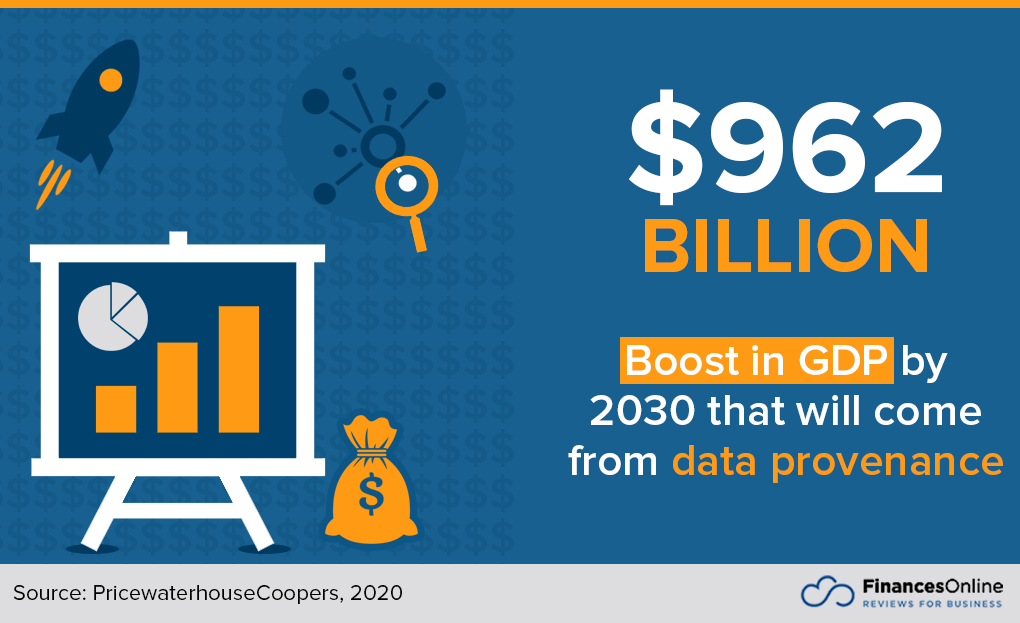While it has yet to achieve mainstream adoption, more and more businesses are realizing the value of transforming their businesses through blockchain technology. With the onset of the COVID-19 pandemic, businesses have used blockchain to accelerate their digital processes for critical use cases like contact tracing and patient record sharing in a secure, decentralized manner. It’s an exciting time for this emerging technology, and consequently, this constantly developing field produces dynamic data from time to time.
In this article, you will get to know crucial blockchain statistics to take note of for this year. From general blockchain market statistics to unique use cases of blockchain technology, you can get a bird’s eye view of the industry. With these insights, you can decide if embracing blockchain technology is the right move for your business.

Blockchain Statistics Table of Contents
Blockchain Market Statistics
The blockchain market is showing signs of promise. The size of the global blockchain market posted double-digit growth in 2020, which is expected to increase in the next decade. This had led companies like Bitcoin and Square to lead the way in blockchain revenue, as well as for IBM and Ant Financial to file many active blockchain patents. By far, the biggest contributor to blockchain spending is the United States, followed by Western Europe. In terms of industry, the banking sector had the biggest spend on blockchain technologies.
Blockchain Market Size and Revenue
- The blockchain market grew by 10.27% in 2020. (MarketsandMarkets Research, 2020)
- In 2020, North America contributed 46% of the growth of the global blockchain technology market. Government organizations adopted blockchain solutions, which contributed to such growth in the US and Canada. (Business Wire, 2021)
- The size of the global blockchain market is expected to grow from $3 billion in 2020 to $39.7 billion by 2025. (Cision PR Newswire, 2020)
- As of February 2021, there were a total of 620.369 million transactions on the blockchain. (Blockchain.com, 2021).
- Worldwide spend on blockchain solutions is forecast to reach $17.9 billion by 2024 and will grow at a compound annual growth rate (CAGR) of 46.4%. (IDC, 2020)
- Experts predict that blockchain will boost global GDP by $1.76 trillion by 2030, which is equivalent to 1.4% of global GDP. (PricewaterhouseCoopers, 2020)

Popular Blockchain Companies
- Bitcoin is currently the most expensive cryptocurrency, with one coin valued at over $55,000 as of February 2021. As such, Bitcoin has been named the currency of the future. (Statista, 2021)
- Cashapp, developed by mobile payments company Square hit $1.63 billion in bitcoin revenue in the third quarter of 2019. Square also invested in $50 million worth of bitcoin in October 2020. (U.S. News, 2021)
- The top three blockchain and cryptocurrency players in China are Bitmain Technologies with a total equity funding of $450 million, Hyperchain with $249 million, and Jixin Blockchain with $100 million. (CB Insights, 2019)
- As of 2019, the largest blockchain patent owner in the U.S. is IBM, with 185 active patent families. IBM is followed by Ant Financial (78), Bank of America (74), Walmart (50), and Mastercard (48). (Statista, 2021)
- As of 2019, the largest blockchain patent owner in Europe is Ant Financial, with 202 active patent families filed at the European Patent Office (EPO). Ant Financial is followed by nChain (81), Siemens (34), and Visa (34). (Statista, 2020)
Blockchain Spending Worldwide
- In 2020, the industry with the largest blockchain spend was banking at 29.7%. Other big spenders on blockchain technology are process manufacturing (11.4%), discrete manufacturing (10.9%), professional services (6.6%), and retail (6%). (IDC, 2020)
- The professional services industry is expected to have the fastest growth in blockchain spending, at a CAGR of 54%. This is followed by healthcare (43.9%) and state and local government (48.2%). (IDC, 2020)
- The US is projected to spend $4.2 billion in 2022, which will make it the largest regional spender on blockchain solution. The next biggest regional spenders are Western Europe ($2.9 billion), the People’s Republic of China ($1.4 billion), Asia Pacific and Japan, ($0.75 billion), Middle East and Africa ($0.5 billion), and others ($1.9 billion). (Statista, 2019)
- Blockchain spend from the automotive industry will increase from $849.5 million in 2019 to$14.731 billion by 2025. (Cision PR Newswire, 2019)
Source: Statista
Data on Blockchain Technology Applications
Though the blockchain market is growing, there seem to be conflicting views within organizations about blockchain adoption. On the one hand, the majority of senior executives think blockchain is set for broad-scale adoption yet only around 40% say that they have adopted it within their organization. A blockchain technology report shows that blockchain adoption is strongest in China. In contrast, 50% of IT leaders said that they were not interested in adopting blockchain solutions. When it comes to cryptocurrency, a technology enabled by blockchain, data shows that the US has the most number of cryptocurrency ATMs as well as blockchain wallet users. However, Ukraine and Russia were the top countries for cryptocurrency transactions based on transaction volume and value.
Overall Adoption of Blockchain Technology
- 88% of senior executives think that blockchain technology will eventually achieve mainstream adoption. (Deloitte, 2020)
- In a survey, 39% of senior executives from around the world said that they have adopted blockchain technologies in their organizations. 41% of these companies had a revenue of more than $100 million. Meanwhile, 46% had a revenue of more than $1 billion. (Deloitte, 2020)
- Adoption of blockchain as a top strategic priority is strongest in China, where 70% agreed that blockchain is in their top five list of priorities. On the other hand, only 42% of organizations in Germany see it as a priority. (Deloitte, 2020)
- The top use cases for blockchain for organizations worldwide are digital currency (33%), data access and sharing (32%), and data reconciliation (31%). Other popular use cases include identity protection (31%), payments (30%), and tracking and tracing (27%). (Deloitte, 2020)
- Meanwhile, another study revealed that 36% of IT leaders are actively searching for blockchain security solutions. However, 50% of IT leaders were not interested in adopting blockchain security solutions. (IDG, 2019)
- 40% of organizations said that they planned to invest $5 million or more in blockchain in the coming year. (Deloitte, 2019)
- China is the country that will benefit the most from adopting blockchain technologies. China is estimated to reap $440.4 billion or a boost of 1.7% on their GDP in 2030. This is followed by the US, which expects a boost of $407.2 billion, Germany at $95.3 billion, and the UK at $72.2 billion. (PricewaterhouseCoopers, 2020)
- In addition, experts predict that within a decade, 10% to 15% of the worldwide infrastructure will use blockchain technology. (PricewaterhouseCoopers, 2020)
- Lastly, blockchain can enhance 40 million jobs around the world by 2030. (PricewaterhouseCoopers, 2020)
Top 10 Use Cases for Blockchain Technology
Digital currency: 33%
Digital currency
33%Data access and sharing: 32%
Data access and sharing
32%Data reconciliation: 31%
Data reconciliation
31%Identity protection: 31%
Identity protection
31%Payments: 30%
Payments
30%Track-and-trace: 27%
Track-and-trace
27%Asset protection: 27%
Asset protection
27%Asset transfer: 25%
Asset transfer
25%Certification: 23%
Certification
23%Record reconciliation: 23%
Record reconciliation
23%Source: Deloitte, 2020
Designed byCryptocurrency Statistics
- The biggest cryptocurrency exchanges based on trading volume are Binance ($28.85 billion), HBTC ($14.44 billion), and Hydax Exchange ($12.19 billion). Other big players are Dsdaq ($11.97 billion), ZG.com ($11.5 billion), and Xheta Global ($11.07 billion). (Statista, 2021)
- In 2020, Bitcoin dominated the market with 66% market capitalization, followed by Ether (8%), and Ripple (4%). Meanwhile, Litecoin only had 1% market capitalization and Monero at 0.5%. In addition, other cryptocurrencies cumulatively had 7% market capitalization. (Statista, 2021)
- By the end of 2020, there were 63 million unique Blockchain.com wallets. The number of blockchain wallets has been steadily increasing since 2015. (Blockchain.com, 2021)
- The US has the most number of cryptocurrency ATMs at 14,112 ATMs or 83.2% of the global market share. Meanwhile, the second spot goes to Europe with 1,258 ATMs (7.4%) and the third goes to Canada with 1,246 ATMs (7.3%). (Coin ATM Radar, n.d.)
- As of February 2021, there are over 1.193 million Ethereum transactions daily. Aside from trading digital currency, you can also create smart contracts through Ethereum. (Statista, 2021)
- The top countries based on the Global Crypto Adoption Index are Ukraine, Russia, Venezuela, China, Kenya, the US, South Africa, Nigeria, Colombia, and Vietnam. (Chainalysis, 2020)
- In 2020, Ukraine sent $8.2 billion and received $8 billion in cryptocurrency. On the other hand, Russia has sent more than $16.8 billion and received $16.6 billion worth of cryptocurrency. Among the reasons for the high levels of cryptocurrency adoption in these countries is the low level of public trust in government, business, and media. (Chainalysis, 2020)
- As of February 21, 2021, the total number of Bitcoin transactions is 272,006. In addition, Bitcoin recorded around 330,000 transactions in December 2020 and 400,000 transactions in January 2021. (Statista, 2021)
Source: Statista
Statistics on Blockchain for Business
Once organizations decide to implement blockchain, they tend to use a private blockchain model. Meanwhile, the top use case is that of data provenance, which is expected to contribute billions to the global GDP in the next decade. However, there are currently mixed views on the relevance and prioritization of blockchain for businesses.
- Private blockchain is the most popular model deployed in organizations worldwide, amounting to 50% of all implementations. This is followed by permissioned blockchain and private blockchain, which both garnered a 45% share of all global implementations. (Statista, 2020)
- 55% of senior executives said that blockchain technology is a critical priority for their organizations. This figure is up by 2% compared to 2019. (Deloitte, 2020)
- 27% of experts in the logistics business from the UK said that blockchain technology has “medium relevance” to their business, while 23% said it had “little relevance” to their business. (Statista, 2019)
- Data provenance, which is recording the history of data, is the top use case for blockchain. This use case will bring an estimated $962 billion boost to global GDP by 2030. This is followed by payments and financial ($433 billion), identity ($224 billion), contracts and dispute resolution ($73 billion), and customer engagement ($54 billion). (PricewaterhouseCoopers, 2020)

Benefits of Blockchain
Business leaders see blockchain as an enabling technology that will further transform their business. More than 80% think that blockchain will enable them to integrate touchless business processes, enhance business functionality, and comply with financial reporting requirements. Investment banks have also reported billions in cost savings due to blockchain technologies.
- In a survey, 87% of senior executives from around the world said that blockchain will allow them to enhance further integration towards touchless business processes. On the other hand, 86% think that blockchain will unlock new business functionality and revenue streams in their industry. (Deloitte, 2019)
- Meanwhile, 83% of organizations said that they are “very or somewhat confident” in meeting financial reporting requirements related to blockchain. (Deloitte, 2020)
- The world’s largest investment banks reported a 70% potential cost savings on central finance reporting due to blockchain technologies. Additionally, they reported a 30% to 50% potential cost savings on compliance, 50% potential cost savings on centralized operations, and 50% potential cost savings on business operations. (Accenture, 2020)
- Lastly, by using blockchain technologies, the world’s largest investment banks can save $12 billion or 38% in annual cost savings. (Accenture, 2020)
Attitude of Executives Toward Blockchain Technology
Source: Deloitte, 2020
Designed byBlockchain Concerns
One of the most commonly cited barriers to adoption for blockchain technology is implementation as it involves replacing or adapting an organization’s existing legacy system. There are concerns as well about cybersecurity, standardization, and interoperability. Even environmental aspects need to be considered by those thinking of adopting blockchain, as blockchain mining uses high energy consumption.
- According to senior executives worldwide, barriers to blockchain are implementation (30%), regulatory issues (30%), and potential security threats (29%). Other reasons cited were lack of in-house capabilities (28%), uncertain ROI (28%), and concerns over sensitivity of competitive information (25%). (Deloitte, 2019)
- 58% of organizations say that cybersecurity is only one among many issues that they considering blockchain technologies of their digital asset strategy. (Deloitte, 2020)
- More than 6,500 blockchain projects leverage mostly standalone blockchain platforms and solutions. The large number of blockchain networks poses an issue with standardization and interoperability. (Finextra, 2020)
- Blockchain miners are using up 0.2% of the world’s total electricity, which makes energy consumption challenging for those who want to adopt blockchain technologies. (101Blockchains, 2020)

Other Blockchain Uses Statistics
Aside from cryptocurrency, blockchain technology has other interesting use cases. For instance, it can be used by fashion houses to authenticate luxury goods or by governments in monitoring the number of its population who have received COVID-19 vaccines. An emerging technology called non-fungible tokens also makes it possible to own and exchange digital content.
- The fintech industry attracted the most number of deals, with 150 closed deals in 2019. On the other hand, there were 36 closed deals in blockchain infrastructure and 31 closed deals in cybersecurity. (Statista, 2019)
- For the third quarter of 2020, Nvidia sold $175 million worth of GeForce RTX 3080. This line of graphics cards is meant for video gaming consoles and graphics cards however, they have also become popular among cryptocurrency miners. (Bitcoin.com, 2020)
- China accounted for 46% of global blockchain patent applications, based on a survey of 100 global companies which filed patent applications. Other leading countries were the US (24%), Japan (8%), and South Korea (7%). (Statista, 2020)
- Dogecoin is a cryptocurrency inspired by internet memes of a fluffy Shiba Inu dog. In December of 2020, its trading price grew by a whopping 420% after Elon Musk tweeted “One word: Doge” with a digital magazine cover featuring a Shiba Inu dog. (Yahoo Money, 2021)
- A non-fungible token, a type of blockchain technology proving ownership of digital assets, for Jack Dorsey’s first tweet was sold at auction for $2.9 million. (CBS News, 2021)
- Blockchain processes can trace the sourcing and track the supply chain for fashion brands, allowing them to prevent counterfeit luxury goods manufacturing, which has cost $4.5 trillion in trade. (Forbes, 2021)
- New York has recently implemented a COVID-19 passport based on IBM’s digital health pass technology, making it the first technology of its kind in the US. (Forbes, 2021)
Source: Statista, 2020
Future Trends in Blockchain Technology
Blockchain technology continues to evolve rapidly, and several key trends will likely shape its future in the coming years. Here are some of the most significant trends to watch:
- Decentralized Finance (DeFi): DeFi is one of the most exciting developments in the blockchain space. It leverages blockchain to recreate traditional financial systems in a decentralized manner, allowing users to lend, borrow, and trade without intermediaries. This trend is expected to grow as more users seek alternatives to traditional banking.
- Non-Fungible Tokens (NFTs): The NFT market has exploded in popularity, allowing individuals to buy, sell, and trade unique digital assets, from art to music. The trend of NFTs is expected to expand beyond art into areas like gaming, virtual real estate, and identity verification, creating new revenue streams for creators.
- Blockchain Interoperability: As more blockchains are developed, interoperability becomes crucial. Future trends will focus on creating solutions that allow different blockchains to communicate and share data seamlessly, enhancing collaboration and expanding use cases.
- Increased Regulation: Regulatory scrutiny is expected to increase with the growing popularity of blockchain and cryptocurrencies. Governments will likely establish clearer regulations to protect consumers and foster innovation while ensuring compliance with existing laws.
- Sustainability Initiatives: Environmental concerns surrounding blockchain, particularly energy-intensive proof-of-work systems, will drive trends toward more sustainable practices. Emerging consensus mechanisms, like proof-of-stake and initiatives focused on reducing carbon footprints, will become increasingly important.
- Enterprise Adoption: More businesses are recognizing the value of blockchain for improving transparency, efficiency, and security. Expect increased adoption across industries, with companies implementing private and consortium blockchains to enhance their operations.
- Blockchain in Supply Chain Management: The ability of blockchain to provide real-time tracking and traceability will revolutionize supply chain management. This technology can enhance accountability, reduce fraud, and improve efficiency by providing a transparent view of the entire supply chain process.
The Lowdown on Blockchain
The blockchain industry is a growing market that is expected to generate billions in blockchain revenue in the next few years. With existing technologies that have yet to reach mainstream adoption and emerging technologies continuously expanding their capabilities, it’s fair to say that it will take years for these technologies to fully mature.
One of the roadblocks to blockchain adoption is business leaders’ mixed reactions to the importance and significance of blockchain technologies. But whatever their stance, it cannot be denied that there are businesses that have realized billions in cost savings by implementing blockchain technology. With use cases spanning from financial applications to fashion and healthcare, it would not be surprising for blockchain technology to be adopted even beyond the pandemic. Notwithstanding its benefits, organizations looking to adopt blockchain have to consider implementation challenges, cybersecurity concerns, environmental impact, and more when evaluating such solutions.
Key Insights
- Blockchain Market Growth
- The global blockchain market grew by 10.27% in 2020 and is projected to expand from $3 billion in 2020 to $39.7 billion by 2025.
- Worldwide spending on blockchain solutions is expected to reach $17.9 billion by 2024, with a compound annual growth rate (CAGR) of 46.4%.
- Leading Blockchain Companies
- Bitcoin remains the most valuable cryptocurrency, with a single coin valued at over $55,000 as of February 2021.
- Square’s Cashapp reported $1.63 billion in bitcoin revenue in Q3 2019 and invested $50 million in bitcoin in October 2020.
- IBM leads in blockchain patents in the U.S., with 185 active patent families as of 2019, while Ant Financial leads in Europe with 202 active patent families.
- Blockchain Adoption and Use Cases
- 88% of senior executives believe blockchain will achieve mainstream adoption, yet only 39% of executives have adopted it in their organizations.
- Top use cases for blockchain include digital currency, data access and sharing, data reconciliation, identity protection, payments, and tracking and tracing.
- Cryptocurrency Trends
- Binance leads cryptocurrency exchanges with a trading volume of $28.85 billion.
- Bitcoin dominated the market with 66% market capitalization in 2020, followed by Ether (8%) and Ripple (4%).
- The U.S. has the highest number of cryptocurrency ATMs, with 14,112 ATMs, accounting for 83.2% of the global market share.
- Benefits of Blockchain
- 87% of senior executives believe blockchain can enhance touchless business processes and unlock new business functionalities.
- Investment banks report significant cost savings due to blockchain, including 70% in central finance reporting and 30-50% in compliance and operations.
- Blockchain Concerns
- Implementation challenges, regulatory issues, and security threats are the top barriers to blockchain adoption.
- Blockchain mining’s high energy consumption is a significant environmental concern, accounting for 0.2% of the world’s total electricity usage.
- Other Blockchain Uses
- Blockchain technology is used for authenticating luxury goods, monitoring COVID-19 vaccine distribution, and enabling non-fungible tokens (NFTs) for digital content ownership.
FAQ
- What is the current growth trend of the global blockchain market? The global blockchain market experienced a growth rate of 10.27% in 2020 and is projected to expand from $3 billion in 2020 to $39.7 billion by 2025. Worldwide spending on blockchain solutions is also expected to reach $17.9 billion by 2024, with a compound annual growth rate (CAGR) of 46.4%.
- Which companies are leading in blockchain technology and cryptocurrency? Bitcoin remains the most valuable cryptocurrency, while Square’s Cashapp reported significant bitcoin revenue. IBM leads in blockchain patents in the U.S., and Ant Financial is the leading patent holder in Europe. Other notable companies include Bitmain Technologies, Hyperchain, and Jixin Blockchain in China.
- What are the primary use cases for blockchain technology? The top use cases for blockchain include digital currency, data access and sharing, data reconciliation, identity protection, payments, and tracking and tracing. These applications highlight blockchain’s versatility and potential to transform various industries.
- How has blockchain adoption varied across different regions and industries? Adoption of blockchain technology is strongest in China, with 70% of organizations prioritizing it. In contrast, only 42% of organizations in Germany consider it a priority. The banking sector is the largest spender on blockchain technology, followed by process manufacturing, discrete manufacturing, professional services, and retail.
- What benefits do organizations see in adopting blockchain technology? Organizations believe that blockchain can enhance touchless business processes, unlock new functionalities, and generate new revenue streams. Investment banks have reported significant cost savings in areas such as central finance reporting, compliance, and operations due to blockchain technologies.
- What are the main concerns regarding blockchain adoption? The primary concerns include implementation challenges, regulatory issues, potential security threats, lack of in-house capabilities, uncertain return on investment (ROI), and the sensitivity of competitive information. Additionally, the high energy consumption of blockchain mining poses an environmental challenge.
- How is blockchain being used beyond cryptocurrency? Blockchain technology is used to authenticate luxury goods, monitor COVID-19 vaccine distribution, and enable non-fungible tokens (NFTs) for digital content ownership. These use cases demonstrate blockchain’s potential to impact various sectors beyond finance and cryptocurrency.
References:
- Accenture. (2020, March 21). Banking on blockchain. Retrieved from Accenture.
- Blockchain.com. (2021). Total Number of Transactions. Retrieved from Blockchain.com.
- Blockchain.com. (2021). Blockchain.com Wallets. Retrieved from Blockchain.com.
- Business Wire. (2021, February 3). Over $8 Billion Growth in Global Blockchain Technology Market 2020-2024 | 46% Growth to Come From North America | Technavio. Retrieved from Business Wire.
- CB Insights. (2019, April 18). The Biggest Blockchain & Crypto Players In China. Retrieved from CB Insights.
- Cision PR Newswire. (2020, May 13). The global blockchain market size is expected to grow from USD 3.0 billion in 2020 to USD 39.7 billion by 2025, at a Compound Annual Growth Rate (CAGR) of 67.3%. Retrieved from Cision PR Newswire.
- Chainalysis. (2020). The 2020 Geography of Cryptocurrency Report. Retrieved from Chainanalysis.
- Cision PR Newswire. (2019, October 31). Global Blockchain Market in the Automotive Industry (2016-2025): Blockchain Spending in 15 Countries with 15+ KPIs. Retrieved from Cision PR Newswire.
- Coin ATM Radar. (n.d.) Crypto ATM Distribution by Continents and Countries. Retrieved from Coin ATM Radar.
- DeAcetis, J. (2021, March 27). Innovative Blockchain Technology Creates New Opportunities For The High-End Fashion Industry. Retrieved from Forbes.
- de Best, R. (2021, January 15). Distribution of the biggest cryptocurrencies from 2015 to 2020, based on market capitalization. Retrieved from Statista.
- de Best, R. (2021, February 15). Number of Ethereum transactions per day from August 2015 to February 14, 2021(in 1,000s). Retrieved from Statista.
- de Best, R. (2021, February 22). Biggest cryptocurrency exchanges based on 24h volume in the world on February 22, 2021 (in billion U.S. dollars). Retrieved from Statista.
- de Best, R. (2021, February 22). Daily Bitcoin (BTC) transactions worldwide as of February 21, 2021. Retrieved from Statista.
- De Meijer, C. (2020, February 29). Remaining challenges of blockchain adoption and possible solutions. Retrieved from Finextra.
- Gogo, J. (2020, November 20). Nvidia Posts Record Q3 Earnings, Sales of GPUs to Crypto Miners Reach $175 Million. Retrieved from Bitcoin.com.
- Gornstein, L. (2021, March 26). What is an NFT? The trendy blockchain technology explained. Retrieved from CBS News.
- IDC. (2020, September 14). Blockchain Solutions Will Continue to See Robust Investments, Led by Banking and Manufacturing, According to New IDC Spending Guide. Retrieved from IDC.
- IDG. (2019, July 31). 2019 Security Priorities Study. Retrieved from IDG.
- Iredale, G. (2020, November 11). Top 10 Blockchain Adoption Challenges. Retrieved from 101Blockchains.
- Kelleher, S. (2021, March 27). New York Just Launched A Digital Vaccine Pass To Restart Concerts, Sports Events And Other Activities. Retrieved from Forbes.
- Kunst, A. (2019, June 13). How do you rate the relevance of blockchain for your business?. Retrieved from Statista.
- Liu, S. (March 4, 2019). Worldwide spending on blockchain solutions from 2016 to 2022, by region (in billion U.S. dollars). Retrieved from Statista.
- Liu, S. (2020, June 3). Model focus for blockchain technology in organizations worldwide 2019. Retrieved from Statista.
- O’Dea, S. (2020, February 25). Most active blockchain investors’ industry focus 2019, by number of deals. Retrieved from Statista.
- MarketsandMarkets Research. (May 2020). Blockchain Market by Component (Platform and Services), Provider (Application, Middleware, and Infrastructure), Type (Private, Public, and Hybrid), Organization Size, Application Area (BFSI, Government, IT & Telecom), and Region – Global Forecast to 2025. (May 2020). Retrieved from MarketsandMarkets Research.
- Pawczuk, L., Holdowsky, J., Massey, R., Hansen, B. (2019). Deloitte’s 2019 Global Blockchain Survey: Blockchain gets down to business. Retrieved from Deloitte.
- Pawczuk, L., Holdowsky, J., Massey, R., Hansen, B. (2020). Deloitte’s 2020 Global Blockchain Survey: From promise to reality. Retrieved from Deloitte.
- PricewaterhouseCoopers. (2020). Time for Trust (2020). Retrieved from PwC.
- Ross, C. (2021, January 29). Elon Musk Tweets In Support Of Dogecoin After Price Grows 420% In A Day. Retrieved from Yahoo Money.
- Textor, C. (2020, December 7). Country breakdown of leading 100 companies filing blockchain invention patent applications globally in 2020. Retrieved from Statista.
- Whittaker, M. and Reeth, M. (2021, January 15). 6 Top Blockchain Stocks and ETFs to Buy in 2021. Retrieved from U.S. News.
- Wunsch, N. (2021, February 9). Largest blockchain patent owners in the United States as of 2019, by number of active patent families. Retrieved from Statista.
- Wunsch, N. (2020, November 3). Largest blockchain patent owners in Europe as of November 2020, by number of filings at the European Patent Office. Retrieved from Statista.























Leave a comment!